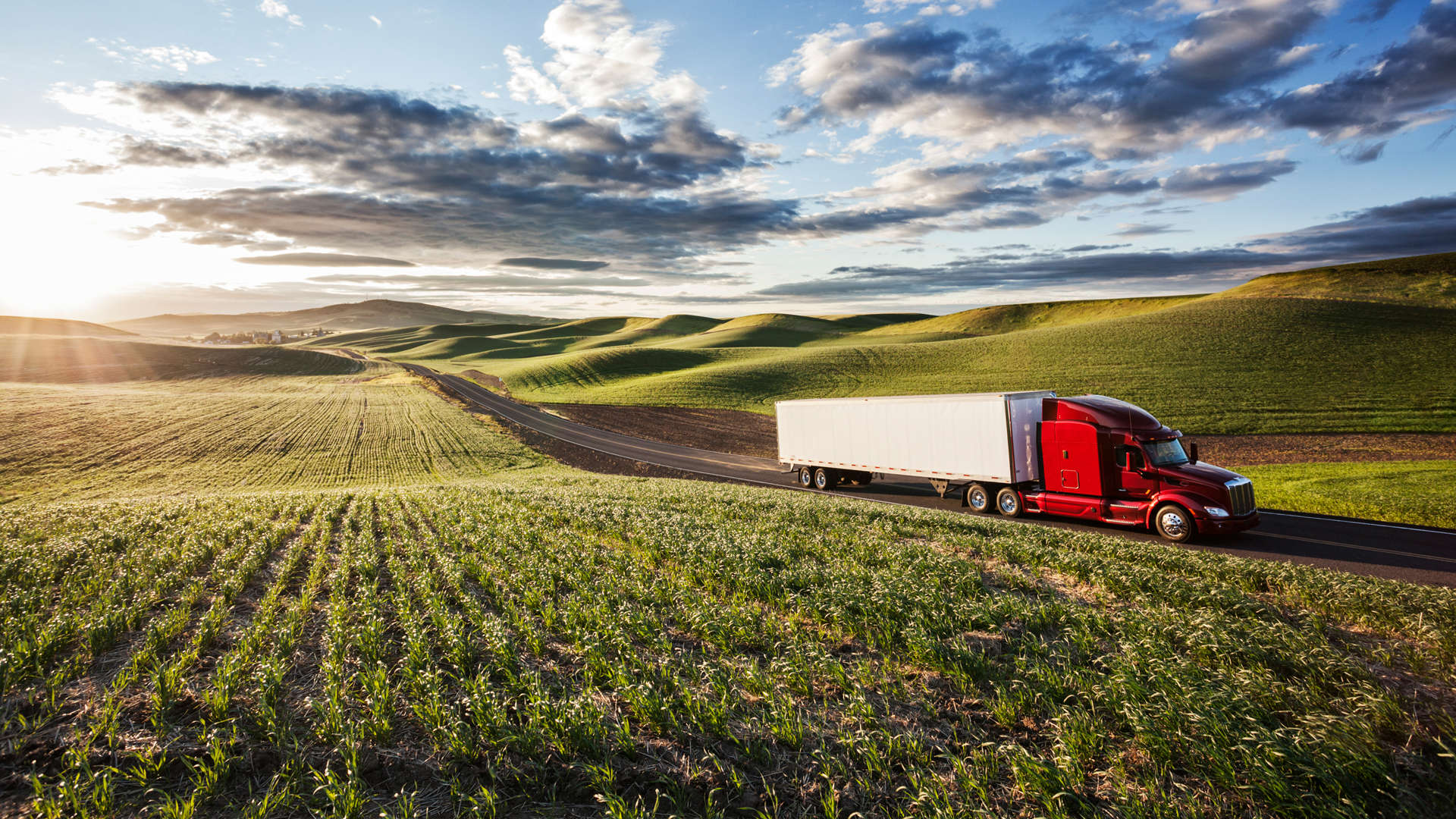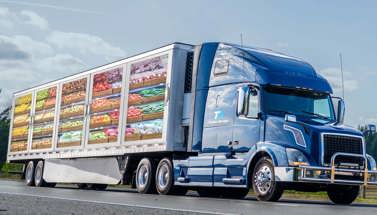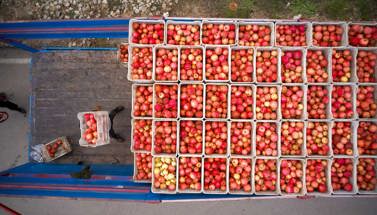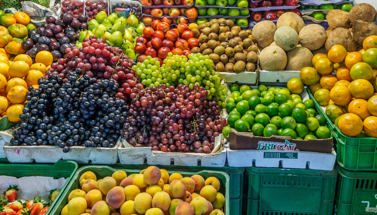
How Seasonality in Food Shipping Sets the Table for Transportation in America
Seasonality regarding food shipping has tremendous impact on truckload capacity and transportation rates. And despite the passing of hundreds of harvest seasons and food shipping seasons in America, successfully planning for and responding to seasonality in food shipping still challenges shippers inside and outside this vertical.
Even if you’re not shipping food and beverages, it’s important to be aware of the impact that food shipping has at different times of the year and in different regions of the country. If you understand the harvest seasons and holidays and how they affect the supply chain, you can plan accordingly. Otherwise, you may find yourself struggling to find trucks or paying premiums to get your freight covered.
At Trailer Bridge, we handle logistics for national food brands and leading seasonal produce shippers. To get a handle on the intricacies of food shipping seasons and how shippers can best prepare for them, we sat down with TB's President of Logistics, Eric Masotti. Under his leadership, Trailer Bridge has earned and sustained the business of some of the biggest names and food and beverage distributors.
Food Shipping Seasons Impact Reefer Capacity and More
The main reason the high seasons for food shipping cannot be ignored is for its effect on temperature-controlled capacity.
Major harvest seasons in California, Florida, Texas and many other states and regions draw refrigerated equipment, also known as reefers, to the region during picking season where rates and demand soar. That’s the basic dynamic at work; however there’s much more to understanding seasonality in food shipping than that.
Produce season in the U.S. is generally pegged as lasting from April to July. But as Eric explains, “There are many harvest seasons across the U.S. that each have an impact on reefer capacity and rates in a particular region and time period.”
Inbound capacity to areas experiencing a harvest season tends to be abundant and rates low—the exact opposite of capacity and rates for outbound freight. Additionally, capacity and rates for dry vans are also impacted. In some cases dry vans (vented vans) can be used to transport produce such as onions and potatoes, while reefer trailers can be used for shipping non-refrigerated cargo during the off-season which impacts dry van capacity.
Produce harvesting isn’t the only reason for seasonality in food shipping. Major holidays, such as Memorial Day, the Fourth of July or Christmas, tie up reefer and dry van capacity. Turkeys and all the trimmings being shipped in anticipation of Thanksgiving are a prime example.
Seasonality in food shipping isn’t just the concern of food shippers and farmers. Whether you’re a cosmetics maker whose truckloads are temperature controlled or an energy drink manufacturer supplying Florida in spring, seasonality affects your ability to ship on-time, in full and at a reasonable cost.
Seasonality Creates Risks and Opportunities for Shippers
Successfully managing seasonal transportation spikes is make or break for all shippers, in particular food shippers. Delays from more volume being shipped during these periods bring a long list of risks. Late deliveries often trigger chargebacks from retailers. Missed deliveries can lead to cancelled purchase orders and loss shelf facings or contracts. Failing to plan well for peak food shipping periods has financial costs and in the worst cases puts food at risk.
In contrast, those who plan well set themselves up for successful sales and future opportunities. Rising to meet a spike in demand help manufacturers grow their market share. Food shippers—and other shippers as well—who understand seasonality can get ahead of peaks to control their capacity and costs. They also have opportunities to get around demand spikes by delaying shipments or by taking advantage of value created by peaks.
Understanding seasonality allows transportation planners to build a supply chain that prioritizes the needs of the freight while minimizing risk for their organization.
Peak Produce Shipping Seasons to Know
Here are the high seasons we at Trailer Bridge think every shipper should consider carefully during their transportation planning. “It’s important to note that produce is running throughout the year – different times of the year are certainly busier than others,” Eric says.
Florida – Mid February to July
“It all begins in February. We start seeing an uptick in international produce shipments, and it just kind of continues into the state of Florida and the actual U.S. produce season,” Eric explains.
Mexican Border – March to July
At the Mexican border crossings of Laredo and McAllen in South Texas, the madness begins in March as produce harvested during Mexico’s earlier growing season makes its way to the U.S.
Texas and Surrounding States – March to June
In addition to outbound produce coming over the border from Mexico, Texas is a huge producer itself. Securing temperature-controlled trailers in Texas can be challenging and rates can soar as domestic harvesting and Mexican imports are shipped out.
Southern California – March to August
Like Florida, California has a climate that is very conducive for produce. It all starts with Strawberries in March and finishes with Oranges in December. As temperatures rise, hot spots for harvesting a wide variety of produce migrate north in the state. Over 75 % of the nation’s production of fruit and nuts comes from California.
Southern Georgia – May to July
A string of harvests combines to create a super surge in trucking capacity, Eric says. “You've got potatoes, you've got peanuts—obviously Georgia peaches—and onions.” While the produce season is most productive during the months of March-July, Georgia does have fall and winter produce as well. The fall and winter season also add produce to the supply chain, but this does not effect rates as much.
South and Southeast – May to July
From Georgia, the harvest season spreads north, west and east. Harvest seasons heat up in Alabama and Mississippi as the weather turns hot and produce is being picked and shipped.
Pacific Northwest – June to December
“The Pacific Northwest is known for their summer and fall produce,” Eric says. “They have a cherry season in Washington state, which starts in early June and lasts through early August. Washington State is also the #1 producer of apples. That season starts in August and wraps up in early November. And as we get closer to Thanksgiving, its Christmas trees season out of Oregon.”
North and South Dakota, Minnesota and the Midwest - August to October
“In the Dakotas, rural Minnesota, most of Wisconsin, Iowa, and rural areas in southern Illinois where there's a lot of farmlands, they start processing their crops during the month of September and that carries deep into the fall,” Eric explains.
5 Best Practices for Preparing for Seasonality in Food Shipping
1. Successful Seasons Start with Forecasting
Many shippers success in navigating seasonality hinges on planning aided by technology. In the case of food shipping, good historical data, sales forecasts and market intelligence are the nutrients that make for a healthy plan.
Strong collaboration with internal teams and the experienced perspective of a seasoned transportation partner ensure essential insights are included in planning transportation needs for coming shipping seasons.
Technology plays a vital role in navigating seasonal demand and preparing based on anticipated needs. Analytical and forecasting tools leveraging AI help food shippers meld historic data with trends, consumer insights, and more to make accurate predictions and forecast inventory levels, lead times, warehousing needs, and transportation requirements.
Beyond forecasting, making the most of high seasons requires leading-edge technology for shipment visibility, load and route optimization and carrier management. To tackle the challenge of sourcing capacity in hard-to-serve lanes, Trailer Bridge recently integrated GenLogs to its suite of advanced tools. The tool also provides visibility to the shipper’s freight routing helping to combat the growing threat of fraud in the trucking industry.
2. Build a Network of Go-To Carriers
Securing experienced and qualified carriers for a limited harvest season is the greatest challenge of produce shippers. They must be contracted well in advance. “Planning is a year-long thing. For the Southeast produce season, April 1st to July 1st, produce shippers are already prepping before the end of the year. They don't want to let that linger. They want to lock in their pricing with their carriers,” Eric explains.
Relationships that span from season to season are common. “Ideally, a produce shipper would probably like to have five carriers they could depend on to get any load in the United States moved no matter where it's going. Relationships like that are built over the years, and require intentionality around maintaining that connection,” he says.
Building a deep and reliable carrier base is not just a best practice for food shippers but one for all. For Trailer Bridge, building strong carrier relationships is at the center of its logistics division and technology investments. The company employs the latest technology from Highway to fully leverage its diverse carrier base to help ensure capacity for shippers. The Highway platform enables Trailer Bridge to efficiently match loads with trusted carriers and connect carriers with backhaul opportunities that support profitability.
3. Align with Partners Providing Flexible Services
With the right partner, seasonal demand peaks can be opportunities for food shippers to increase sales without strain and unnecessary expense.
Responding to demand spikes requires services such as reefer capacity, flexible warehouse space and trained, ready staffing. Importantly, it requires a seamless integration of these resources that enables them to flexibly and reliably respond to your needs.
Additionally, a partner experienced in food logistics and their seasonality helps food shippers meet challenges unique to food transportation with confidence. The challenges of temperature-controlled logistics are made all the more challenging when delivered under pressure.
During our many years transporting and storing food, Trailer Bridge has provided the solutions food shippers need to meet seasonal demand surges without disruption. We know that food shippers need additional transportation capacity and temporary warehousing when they need it. We also know that they need the ability to quickly scale their operations back once the spike has passed.
4. Work With Food Shipping Experts
An experienced transportation partner gets the job done for you and removes the risks to you as part of their job. A pro knows food safety standards and provides trailers that are in compliance with the FDA Food Safety Modernization Act (FSMA) rule on Sanitary Transportation of Human and Animal Food.
The goal of this rule is to prevent practices during transportation that create food safety risks, such as failure to properly refrigerate, inadequate cleaning of vehicles between loads, and failure to properly protect food. The key requirements are:
- Good Equipment: Trucks and trailers must be designed and maintained to ensure the food being transported is safe. That means making sure trailers are suitable, cleanable and capable of maintaining temperatures required for food to be transported safely.
- Established Processes: Transportation operations must specify the measures to be taken during transportation to ensure food safety. Those measures address temperature controls, handling guidelines for protecting ready-to-eat food, and rules for protecting food from cross-contamination.
- Training: Formal programs must be in place for training carriers about sanitary transportation practices and documenting that training was performed.
- Record Keeping: Systems must be in place for preserving documentation of written procedures, agreements and training required of carriers.
How FMSA works in a practical sense varies. Trailer Bridge works with carriers who commit to these standards. Working with an FMSA-compliant 3PL helps shield produce and other food shippers from liability as well as loss. Delays put produce at risk and shippers in a position of potentially having to pay inflated rates to secure a replacement.
5. Communication and Technology Support Success
An unbroken cold chain and chain of custody are essential to ensure the safety and quality of the food being transported. Shippers need to know where their product is and that it’s safe at all times. For this reason, carriers in this category must remain in close communication with shippers and receivers.
“In produce shipping, you need answers quick because when things go wrong, they go wrong quickly and you need to have quick solutions. That starts with communication and being reachable 24/7,” Eric says.
Shipping frozen and fresh foods is no different. Trailer Bridge finds that a combination of phone calls and advanced tracking technology is required to keep shippers in control. Having one source of oversight and one point of contact for all shipments is a tremendous time and stress saver for shippers during a hectic peak season.
He adds that tracking is also a mandatory today. “You simply can't operate in this business dry or refrigerated without it tracking.” TMS allows shippers to track their trailers, and in a lot of cases, check trailer temperature and humidity without having to wait for or ask for a data log.
A centralized means for monitoring produce loads, and intervening when necessary, is invaluable to produce shippers at the height of peak season. Trailer Bridge has invested heavily in leading-edge tracking capabilities. By combining advanced technology with committed customer service, Trailer Bridge provides food shippers with a definitive advantage in meeting seasonal demand.
Related Articles




